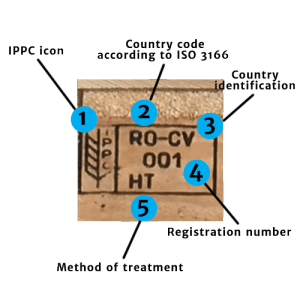FAQ: EPAL Euro Pallets
What are Euro Pallets?
The standard size for EUR 1 EPAL pallets is 1200 x 800 x 144 mm.
Euro Pallets heat-treated and dried (KD) with humidity level less than "

Questions and Answers
How do I place my order?
Orders can be placed directly on the online shop or send your quote to our orders department email: info@epaleuropallets.com
(please add quotation number and delivery address if possible)
How can I pay for my order?
The customer can pay for the goods in the following ways:
- Bank transfer
- PayPal
The availability of a specific quantity of pallets in the warehouse and the final price can be found out by calling the indicated contact numbers.
How much is the delivery fee?
How to make a pre-order for bulk delivery?
Pallets are delivered in unlimited quantities at any date and time convenient for the customer. In order to place an order, you must contact the company’s manager by calling the contact phone number, specify the total required quantity and type of container. The application can also be sent to the specified e-mail address.
Do you have a hard time making a choice or do you need advice? Specialists will be happy to answer all questions.
How long will my delivery take once I order?
How many pallets can be delivered by truck?
Taking into account practical observations and deliveries, we can create the following summary of data:
- 5t (32-42 cubic meters) – up to 300 euro pallets
- 10t (35-45 cubic meters) – up to 400 euro pallets
- 20t (82-96 cubic meters) – up to 750 euro pallets
Will I need a forklift truck to unload pallets?
What is your returns or refund policy?
Are all EPAL pallets heat treated?
What are the rules for Euro pallets?
Euro pallets are manufactured according to strict quality regulations and are occasionally inspected by independent firms. All pallets should meet certain criteria before being approved.
The absence of an approval logo indicates a counterfeit pallet, which can cause damage to the product transported or handled by it. Transporting products on an unauthentic pallet can lead to the refusal of products by customers or sometimes serious penalties from authorities. Other requirements include:
- Materials: 11 tables in high-quality wood, 9 solid woodblock, and 78 nails.
- Euro pallet Dimensions: Length 1200 mm (tolerance limit + 8/-5); Width 800mm (tolerance limit + 8/- 5x mm); Height 144mm (tolerance limit + 10/ – 0x mm).
- Weight: approximately 25kg.
- Workload: 1500kg with a constant load on the entire pallet.
- Width of the board: Top board should have a width of 22 by 25 mm, while the bottom board should have a width of 22 to 24 mm.
- Only approved companies should manufacture, mark, and repair Euro pallets.
- Manufacturing shall take place following UIC Code 435-2 standards and repairs following UIC Code 435-4 standards.
- Euro pallet should contain the EPAL, EUR, or DB markings. In other cases, the mark of the European railway companies can replace the EPAL.
- All wooden pallets shall be marked with the ISPM NO-5 standards.
What is the global standard for Euro Pallets?
Are Euro Pallets treated chemically?
Euro pallets from EPAL are only heat treated. The hot air circulates around the pallets until a certain core temperature is reached and a sufficient amount of water is removed from the wood. As a result, pallets contain no chemicals or allergens at the end.
What is the stamp on the central pallet block?
You can check where a pallet was produced using the pallet stamps. Please examine the following graphics:
What type of wood is used to make Euro Pallets?
- Coniferous (fir, pine, spruce)
- Softwood (alder, birch)
- Hardwood (ash, acacia, oak, maple, sycamore, European chestnut)
Wood pallets offer a great blend of weight, durability, and cost. Furthermore, there are a lot of pallets recycling infrastructure, which helps to promote the refurbishment and reuse of wood pallets. This are also highly reparable if damaged.
What is a phytosanitary certificate?
This standard is called ISPM 15. All pallets used to transport products in international markets must undergo phytosanitary treatment. The sanitary treatment certificate certifies the safe use of pallets and pallets. Sanitary treatment is carried out by applying temperature exposure (HT), drying in special chambers (KD), and treatment with methyl bromide (MB).
Why do pallet corners have rounded edges?
What does "IPPC" on the EPAL pallet block mean?
The agreement on mandatory handling of containers was signed by all organizations involved in the process of international cargo transportation, including Ukraine.
Processing is carried out in a heat chamber at a temperature of +560 C for 30 minutes without a break. Both the outer surface of the tree and its core are exposed to the influence of high temperatures.
Difference between blue and red EPAL pallets?
The EPAL system is an open sharing system. The customer buys the pallet directly from the manufacturer and uses it as he sees fit. EPAL is considered to be the most cost-effective scheme.
What does the marking EUR, EPAL, UIC mean?
The EPAL mark indicates that the pallet belongs to the European Association of Manufacturers. The transition to uniform standards was made in the mid-1950s. It greatly simplified loading and unloading operations, placement of goods on the cargo platforms of cars and railway wagons.
EPAL pallets are produced by almost 2000 companies in 30 countries of the world. The logo is placed in an oval on the outer blocks, where the release date, owner’s license code and IPPC procedure number are indicated.
The UIC designation belongs to the International Union of Railways. The designation “UIC” is a trademark, the violation of the rules of its use is subject to administrative liability. The production of pallets of this category is regulated by the international standard UIC 435-2. EPAL’s technical regulations were written on its basis. To produce pallets with this mark, the manufacturer must have the appropriate license.
Certified FIN pallets are marked with the “FIN” mark . Their dimensions are 1000 × 1200 × 145 mm. The “FIN” sign is placed in a rectangle by burning it on the right-hand supporting pillars. Information in the form of numbers is placed on the central support legs: date and year of manufacture, manufacturer’s license number, manufacturer’s code, date of sanitary treatment.
Knowing the marking of pallets helps the customer to better navigate in the choice of the type of packaging. Pallets are selected depending on the specifics of the transported cargo, its volume, maximum transportation time. It is not allowed to use unmarked containers in the framework of interstate transport.
Value Added Pallet Service
We manufacture a wide variety of wooden pallets and crates. All wooden pallet crate boxes are made from high-quality wood in accordance with industry standards. We ensure good quality product at competitive rates to our clients.
DELIVERY DEADLINES
Strict adherence to deadlines.
Delivery time starting from 1 day.
COMPANY HISTORY
We are a reliable company with 12 years of working experience.
FLEXIBLE DISCOUNTS
We offer discount deals on pallets and half-pallet orders.

Shipping Solutions
Pallet delivery & payment terms depend on retail or wholesale
WAREHOUSE RESERVES
Container cases and trays dimensioned for standard pallets
BEST PALLET PRICES
Cheapest pallet delivery services for courier or business logistics
Production Capacity
We produce a wide range of pallets and load carriers for use in industry and international business. Manufactured on state-of-the-art, robot-assisted production lines, our quality plastic and wooden pallets meet international standards and very stringent hygiene requirements.
Do you have specific inquiries or questions?
- over 20000 pallets per day
- over 4.8 mill. pallets a year
- One of the largest drying facilities in southern Germany
- Very high storage capacity
- IISO-certified since 1995
- International production standards
- Decades of experience
- Large product range
- Special production line solutions to meet individual requirements
- Specialist in system pallets
- Reliable transport logistics
- Guaranteed timely deliveries

